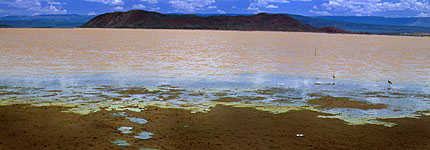Parks & reserves: Lake Baringo
 Managed by:
Managed by: Baringo County
Safari Card: No
|
 Lake Baringo with hippo footprints on the foreground. J.Y./Kenyalogy.com
Lake Baringo with hippo footprints on the foreground. J.Y./Kenyalogy.com
|
General info
Lake Baringo is one of the water bodies that line up on the floor of the Great Rift Valley, the Earth's scar that crosses the East of Africa north to south. After the huge Turkana, Baringo is the second northernmost and largest in Kenya, with 130 km². Baringo and Naivasha stand up as the only freshwater shallows in the Kenyan Rift.
The lake is not officially ranked as a protected area, but that doesn't mean you don't have to pay. On the road to the lake, the Baringo County established a Visitors and Statistics Centre, which is just a fancy name for a toll gate. Fortunately, the 200 Kenyan shillings per person (for non-residents) are still very far away from the USD 80 you will have to pay in some national parks.
The large fresh water body is a shelter for more than 400 bird species that give the area its main attractive. The lake is -or used to be- a quiet and solitary oasis embedded in the abrupt and arid land that foresees the northern deserts. Until the end of the 19th century, Baringo and Bogoria were only visited by caravans of slaves; the remains of Fort Baringo, dating back to those years, are still visible. The lake was first described by Scottish explorer Joseph Thomson in 1883. Nine years later, in 1892, the English geologist J.W. Gregory explained the formation of the Rift Valley from his observations at Baringo.
Tourism in the area has increased over the last years, hence Baringo is no longer a place off the beaten track. Still, at the lake's shores you can enjoy a peaceful mood very different from the most crowded parks. Its chocolate waters, stained with the region's soil, change in tonality along the day and depending on the sky's colour. After the sunset, you may watch hippos emerging from the water to graze in noisy groups at the moonlit pastures.
The lake is also populated with crocodiles, considered harmless by the local Njemps people, paranilotic fishers and shepherds related to the Maasai that speak a dialect of the Maa language. The Njemps sail the lake in small boats and dip into the water for fishing, while crocodiles wander about with the same purpose. The locals state that fish abundance has supported the croc population in such a way that the reptiles have forgotten the taste for mammal's meat. In fact, the high fish concentration has accustomed the Njemps themselves to this kind of food, which is not very frequent among the pastoral tribes.
It is true though that the lake's crocodiles are small and, therefore, neither they are as dangerous as their bigger relatives nor they have been hassled by hunters. In spite of all, in 1981 a presumed man-eating reptile was shot down.
Baringo's fresh waters host a variety of fish which is not to be found in the alkaline lakes and which attracts a broad range of water birds. The rocky isle of Gibraltar, at the eastern shore, is blessed with the largest Goliath heron population in all East Africa. Another place of interest is the escarpment which lies next to the town of Kampi ya Samaki, at the western shore, where a lucky watcher could find Verreaux eagles, Hemprich's hornbills and bristle-crowned starlings.
In addition to bird watching walks and boat trips under the guidance of a professional ornithologist, the lake offers a range of activities which include fishing, water sports (ski, wind-surfing), camel rides, day trips to the nearby Lake Bogoria National Reserve and visits to a Njemps village, where you can get a sip of the local handcrafts and dances. Activities are mainly run by the lake's two lodges, Lake Baringo Club and Island Camp. Local fishermen also offer boat trips, during which they throw fresh fish as a bait for the fish eagles.
|



